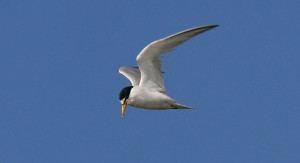With driving directions in hand, I darted through freeway interchanges, skirted construction zones, made quick lane changes, and dipped into a dark tunnel, emerging at last at the Alameda National Wildlife Refuge. So I had to admire the built-in navigation system of the endangered California least terns that find their way here each spring from as far away as South America.
In the past, terns liked to nest on wide sandy beaches, but people like beaches too, and people usually win out over terns. As their habitat dwindled, the terns found refuge on coastal military bases and at airports. The terns started breeding on the tarmac at the Alameda Naval Air Station when it was still in operation. At least one-third of nesting California least terns are protected on military land such as this former base and the still-active Camp Pendleton in Orange County.
When the Alameda base closed in 1997, the nesting area’s fate was up in the air along with that of the rest of the area. While authorities from a variety of jurisdictions weighed, rejected, and reconsidered plans for the site, the Golden Gate Audubon Society, Friends of the Alameda Wildlife Refuge, and Citizens Committee to Complete the Refuge pushed for protecting the tern colony. As a result, the site became a de facto refuge. Each year the terns have returned, while the U.S. Navy, U.S. Fish and Wildlife Service (USFWS), Department of Veterans Affairs (VA), East Bay Regional Park District, and the City of Alameda were hammering out the final plan for the land. The latest proposal seems to be one all parties can live with–including the terns. The VA will build a medical complex and columbarium adjacent to the refuge, which will be managed by the park district and USFWS.
In the middle of the refuge is a 9.7-acre tern nesting area enclosed by a cyclone fence and a shorter “chick fence” to keep the little ones safe. Along with perfect feeding waters in the Bay, some tern-friendly amenities installed by USFWS and volunteers have helped this tern breeding colony become Northern California’s largest. Sand and gravel top the tarmac; hundreds of A-frame shelters protect birds from the sun, hawks, and falcons; plastic crow effigies deter other avian predators; and professional trappers sometimes catch feral cats, skunks, and raccoons. The work has paid off: The nesting colony has grown from 25 pairs in 1980 to about 300 pairs today.
Both parents feed anchovies, herring, and silversides from the Bay to their young, and as the season draws to a close, the fledglings practice flying on the runway. To cool their feet they stand on the faded white lines facing the direction they’ll soon be flying, headed south with no map needed.



-300x196.jpg)
-300x180.jpg)
